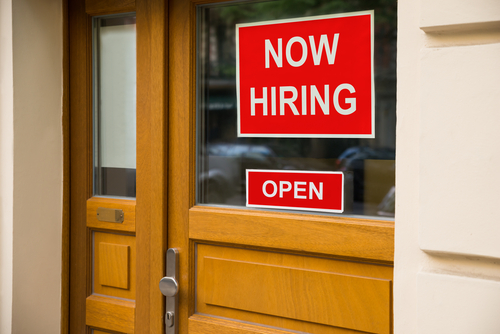Over the last 3 months, we’ve watched the labor market lurch from one extreme to the other. This time last year, there were reports of thousands of workers applying for every open position. Fast-forward to the present day, and we’re seeing a jobs market where employers are struggling to hire the workers they need. Supply and demand for labor has suddenly turned on its head.
This sharp turnaround is especially noticeable within hospitality, a sector that has been one of the most vulnerable to pandemic restrictions. After adjusting to closures, implementing new safety measures, and reopening at often limited capacities, the struggle to find staff for summer is the latest hurdle in the way of restaurants, bars, and the wider food services industry. It has not been an easy ride. Now, restaurants and bars are turning up the creativity to fulfill this latest need to secure and retain employees.
The Topsy-Turvy Industry
Looking at the labor market, hospitality and catering vacancies are lying unfilled and building up. In the first week of June, we had 467,590 advertised jobs lying vacant across the United States on Adzuna.com—up from fewer than 250,000 at the start of 2021. Live openings have topped 450,000 for 4 consecutive weeks as employers struggle to fill open positions.
In-demand positions include servers, restaurant managers, line cooks, bartenders, and chefs. And top hiring companies include Pizza Hut, hiring for over 22,000 staff; Starbucks, looking for over 18,000 staff; and McDonald’s with over 12,000 vacancies.
There are thousands of openings in every state, with the highest demand for hospitality and catering staff in Texas (43,000+ jobs); California (34,000+ jobs); and Florida (28,000+ jobs).
Securing and Retaining Talent
In an effort to meet this unprecedented demand, hospitality employers are getting creative when it comes to offering incentives to encourage employees to fill roles. Now is a critical moment as they look to scoop up graduates and students looking for a job for the holiday season and tempt them away from summer internships or job openings in other industries. For jobseekers, it’s a great time to earn extra cash.
The most common incentives being offered include sign-on bonuses and referral fees. We’ve spotted employers offering as much as $5,000 in bonuses to workers who join and stay the summer season. In total, around 1 in 9 jobs within the sector are offering some sort of financial incentive to new joiners.
This is on top of the financial incentives being offered by some states to help encourage more unemployed Americans to get back to work. For example, Oklahoma is offering $1,200 to a limited number of unemployed workers who head back to work, and Arizona, Colorado, Connecticut, Montana, and New Hampshire have also all started back-to-work incentive schemes.
Is the Industry Missing a Trick?
But contrary to moves being made, it seems jobseekers are looking for more than money to tempt them back to work. Despite all the cash bonuses on offer, is the industry still missing a trick?
A survey of jobseekers by TA platform Talroo reveals that child care and home care are top issues preventing many workers from taking new jobs. With many children still attending school virtually, some households simply can’t allow for a parent to go back to work. One-third of the working population—equal to 50 million Americans—has a child under 14, demonstrating the scale of this obstacle.
Other industries have started to respond by introducing childcare support. Amazon offered backup child care to employees throughout the pandemic, while edtech unicorn Guild Education recently opened an affordable on-site day care. But it’s a tough ask for the hospitality and catering industry to follow suit. The nature of food services means roles are generally spread out among smaller establishments rather than being clustered together in central campuses, and overall worker compensation is also much lower.
Add to this the growing number of vacancies in other industries competing for the same staff. There are more than 1.2 million advertised logistics and warehouse vacancies, with giants like Amazon recently raising all wages to $15 an hour in a move likely to force many other employers to also raise wages to compete. Retail, too, is on the up, hiring more than 455,000 workers.
Go Beyond Money to Win Over Workers
So how can the food industry compete?
We’re starting to see hospitality and catering employers taking note of other industries and creating better overall packages for their staff. This includes giving restaurant and bar workers access to wider employment perks the industry has typically ignored, such as health insurance, money toward education, and better and more flexible hours.
There is also a growing focus on professionalizing the industry and helping workers see a longer-term career within workplaces rather than simply taking a role as a stopgap or summer job. Chipotle has increased wages to $15 an hour and has introduced a career pathway allowing employees to earn $100,000 within 3 years by advancing to restaurateur, the highest general manager position.
In-N-Out Burger offers some of the best benefits for employees, including enhanced vacation leave, a profit-sharing and 401(k) plan, and free meals, with USAToday reporting that managers are paid $160,000 a year.
As the labor market heats up and bars and restaurants scramble to get enough staff for the busy summer season, the most successful recruitment campaigns will come from brands that have the ingenuity, as well as the cash, to draw in permanent employees to be there for the long haul.
Andrew Hunter is cofounder of global job search engine Adzuna.
The post How the Restaurant Industry Is Competing for Talent appeared first on HR Daily Advisor.
